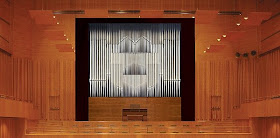More from the 2011 ORCiM festival: Lena Weman Ericcson introduced an almost terrifyingly ambitious project in Sweden: the Studio Acusticum Organ. Studio Acusticum is an award winning concert hall with, amongst others, a ceiling that can be moved up or down to about 8 meters (over 25 feet), resulting in a maximum reverberation of nearly 3 seconds. The organ, being built by Gerhard Woehl, boasts a disposition of more than 215 stops, including 89 sounding registers and the innovative 'floating' Harmonics Division, has programmable 'Sperventille' to manipulate the airflow to the bass and treble of each division, can be played and listened to from anywhere in the world through the internet, etc. More information on the instrument can be found here. (For more aspects, click on 'more' under 'news'.)
In itself an instrument builder's project, the artistic research appears on the horizon when contemplating the compositional potential of the innovations. Ligeti's Volumina is world-renown for its inappropriate use of the on/off button at the beginning of the piece - what can be done with the Sperventile is clear from the sounds on this video. The Harmonics Division can be used to produce entirely new sounds by emphasizing any part of any given pitch. In all, the Harmonics Division has over 100 pitches per octave, enabling the organ "to bridge the gap between acoustical music and electronic sounds purely by acoustic means". Real-time control of each individual pipe is possible, thus it can be used for anything from adding a single mutation stop to extreme purposes such as speech synthesis (using the real-time computer-controlled facilities offered by the organ).
Composers all over the globe, go to Pitea (live or virtually) and start creating new music!

No comments:
Post a Comment